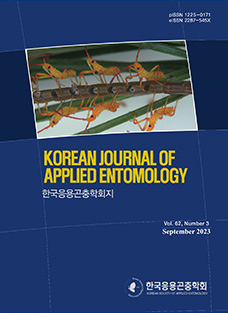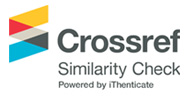The family Stathmopodidae, 1913, currently comprises more than 400 species, with approximately 230 species belonging to the genus StathmopodaHerrich-Schäffer, 1853, accounting for over half of the family’s diversity (Nieukerken et al., 2011;Terada, 2016). In the Korean Peninsula, the genus Stathmopoda was first reported by Park et al. (1983), with four species, and most recently, S. gemmiconsuta Terada was recorded by Kim et al. (2024), resulting in a total of 14 documented species to date. In this study, we provide descriptions and figures of adults (male and female) and their genitalia for the newly recorded species S. callicarpicola, further expanding the species diversity of the genus on the Korean Peninsula. Additionally, morphological diversity is enhanced by observing the previously understudied fine structures of the frenula using Scanning Electron Microscopy (SEM).
Materials and Methods
Collection
Four specimens were gathered using the light trap (220 V/ 400 W) and the bucket trap (12 V/20 W). Each specimen was then pinned through the thorax with its wings fully spread and subsequently dried in an oven set to 50°C for at least two weeks.
Identification
Specimens were identified by following the dissection procedures detailed in Kim et al. (2017). All dissections took place under an EZ4 stereomicroscope (Leica, Germany). Photographs of adult specimens and their genitalia were acquired using a Leica S8APO stereomicroscope (Leica, Germany) equipped with a Tucsen Dhyana 400 DC digital camera (Tucsen, China) and a Leica LED 5000 HDI dome illuminator (Leica, Germany). Multifocal images were compiled into single composite images using Mosaic (Tucsen, China) and Helicon Focus (Helicon Soft, Ukraine). Final touches to the images were performed in Adobe Photoshop 2024 (Adobe, USA). For diagnosis, when comparative species had not been reported from the Korean Peninsula, plates provided by Terada (2016) were consulted.
SEM imaging
A 5 mm-wide, conductive carbon double-sided tape (Nissin EM Co., Japan) was first affixed to the SEM plate, and the sample was positioned on the tape. Under vacuum conditions maintained by an Adixen 2005 SD vacuum pump (PFEIFFER VACUUM, Germany), the sample was then coated with platinum for 90 seconds using a Leica EM ACE200 (Leica, Germany). Imaging was carried out on a Gemini 500 Field Emission (FE)-SEM (Carl Zeiss, Germany) at the Center for University-wide Research Facilities (CURE) of Jeonbuk National University, and sample movement and orientation were managed using ZEN core Documentation (Carl Zeiss, Germany).
Results
Taxonomic accounts
Family Stathmopodidae Meyrick, 1913
Stathmopodidae Meyrick, 1913: 310. Type genus: Stathmopoda Herrich-Schäffer
Genus StathmopodaHerrich-Schäffer, 1853
StathmopodaHerrich-Schäffer, 1853: 54. Type species: Phalaena (Tinea) pedella Linneaus, 1761
BoocaraButler, 1880: 562. Type species: Boocara skelloniButler, 1880
PlacostolaMeyrick, 1887: 280. Type species: Placostola diplaspisMeyrick, 1887
ErinedaBusck, 1909: 94. Type species: Erineda elyellaBusck, 1909
AgrioscelisMeyrick, 1913: 96. Type species: Agrioscelis tacitaMeyrick, 1913
KakivoriaNagano, 1916: 138. Type species: Kakivoria flavofasciataNagano, 1916
Stathmopoda callicarpicolaTerada, 2012 (신칭: 호랑무늬 꼭지나방) (Figs. 1–2)
Stathmopoda callicarpicolaTerada, 2012: 52–54. Type locality: Japan.
Material examined. Four individuals: one male and one female, Yongho-ri san 138-1, Hansan-myeon, Tongyeong-si, Gyeongsangnam-do, Korea, 14.viii.2024, I.W. Jeong and D. Ra, gen. slide. No. IPE JBNU-13265 (male), 13266 (female)/ I.W. Jeong; one female, Haean-dong san 217, Jeju-si, Jeju-do, Korea, 21.vii.2024, J. Park, gen. slide. No. IPE JBNU-13302/ I.W. Jeong; one female, Sanggar-ri san 129, Aewor-eup, Jeju-si, Jeju-do, Korea, 21.vii.2024, J. Park, gen. slide. No. IPE JBNU-13305/ I.W. Jeong.
Diagnosis. This species exhibits an apparent pattern of imago variation between males and females. In male, this species is superficially similar to S. magnisignata Terada, but can be distinguished by the color of the thorax and the marking of forewing. In S. magnisignata, the thorax is generally dark brown, and the forewing has a triangular blotch near the base on the dark brown background. But in this species, the thorax is ocher caudally dark brown, and the forewing has oval-shaped blotches at 1/5, 1/2, and 3/4 on the dark brown background. In female, this species is similar to S. luxuriivora Terada, but there are differences in the pattern and marking of the forewing. In S. luxuriivora, the second fascia narrows toward the costal. But in this species, the second fascia narrows toward the posterior. In male genitalia, this species is the most similar to S. flavescens Kuznetsov. However, this species has slightly wider gnathos and narrower uncus than S. flavescens, and in the aedeagus, the sclerotized plate near the base is approximately three times longer.
Description.Adult (Fig. 1). Wing expanse 11.2–11.5 mm. Head. Frons ocher; vertex grayish silver; occiput grayish brown. Antenna pale ocher with cilia; scape pale gray at the apex. Labial palpus ocher; first and second segment pale ocher; third segment ventrally gray. Throax. Tegula ocher, pale brown at caudal margin. Thorax ocher; prothorax dark brown; thick dark brown M-shaped line at middle; brown blotch at the caudal margin. Abdomen grayish brown; grayish brown scales caudally at each segment. Wing. In male, forewing dark brown; costal dark grayish brown; first blotch at 1/5, ocherous triangular with rounded vertices, narrower towards apex; second blotch at 1/2, ocherous parallelogram; third blotch at 3/4, unclear and dark ocher, not reaching costal; fringes dark brown. In female, forewing ocher; costal grayish brown from base to 7/10; three pale brown or brown fasciae at base, 1/3, and 2/3; first fascia base to 1/8; second fascia extending from costal 1/5 to 1/2 from posterior 1/4 to 2/5, narrowing from costal to halfway of CuP and widening towards posterior at base; third fascia half crescent-shaped, unclear, connecting with second fascia by pale brown streak along posterior; pale grayish brown streak from 4/5 to apex along posterior margin; gray at apex; fringes, some ocher and some grayish brown. Hindwing dark brown, darker towards the apex; in male, one frenulum originating from three pairs of strands; in female, three frenula originating from each strand; fringes dark brown.
Male genitalia (Fig. 2A-B). Uncus narrow with numerous setae laterally, apex blunt and curved downward. Gnathos 5/6 length of uncus, broad, tongue-shaped, slightly downturned. Valva narrower to apex with blunt apex; costa convex, welldeveloped; cucullus 1.5 times longer than uncus, numerous setae inwardly, slightly curved narrow triangular, blunt at apex; sacculus sclerotized, with some setae, widening from the base up to 3/4 and narrowing afterward, blunt at apex. Vinculum elongated; saccus 2/9 length of uncus, round cephalically. Juxta small oval-shaped. Aedeagus ca. 2.5 times longer than uncus, a narrow and arched sclerotized plate extending from the base to 1/3 of the aedeagus.
Female genitalia (Fig. 3). Papillae anales length 2.5 times longer than width, weakly sclerotized, with short setae. Eighth abdominal segment triangular cephalically; long setae irregularly arranged along the caudal margin. Apophyses posteriores slightly shorter than 1.25 times apophyses anteriores. Ostium bursae wide tub-shaped. Ductus bursae widening caudally. Corpus burae with sparse microspines overall, with bar-shaped signum at the cephalic margin. Bulla originating at the middle of the corpus bursae, large, stout. Ductus seminalis narrow.
Host plant.Callicarpa japonica Thunb. (Lamiaceae) (Terada, 2016).
Distribution. Korea, Japan, China (Terada, 2016;Wang et al., 2021).











 KSAE
KSAE





